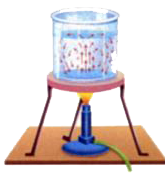Particles of comphor move around on the sruface of water. Why?
To understand why particles of camphor move around on the surface of water, we can break down the explanation into a few key steps:
1. Understanding Surface Tension:
- Water has a property called surface tension, which is the elastic tendency of a fluid surface that makes it acquire the least surface area possible. This is due to the cohesive forces between water molecules.
2. Dissolution of Camphor:
- When camphor is placed on the surface of water, it begins to dissolve. However, the rate of dissolution is not uniform across the surface. Some areas may have a higher concentration of camphor, while others may have less.
3. Effect on Surface Tension:
- As camphor dissolves in water, it reduces the surface tension in the areas where it dissolves more rapidly. This means that the surface tension is not the same everywhere on the surface of the water.
4. Resultant Force:
- The difference in surface tension creates a net force that acts on the camphor particles. The particles will experience a greater force in areas of higher surface tension compared to areas of lower surface tension.
5. Movement of Camphor Particles:
- Due to this variation in surface tension, camphor particles will move towards areas of higher surface tension. This movement can be likened to "dancing" on the surface of the water as they are pulled by the resultant force created by the differences in surface tension.
6. Conclusion:
- Therefore, the movement of camphor particles on the surface of water is a result of the non-uniform surface tension caused by the varying rates of dissolution of camphor in different areas.
- Water has a property called surface tension, which is the elastic tendency of a fluid surface that makes it acquire the least surface area possible. This is due to the cohesive forces between water molecules.
- When camphor is placed on the surface of water, it begins to dissolve. However, the rate of dissolution is not uniform across the surface. Some areas may have a higher concentration of camphor, while others may have less.
- As camphor dissolves in water, it reduces the surface tension in the areas where it dissolves more rapidly. This means that the surface tension is not the same everywhere on the surface of the water.
- The difference in surface tension creates a net force that acts on the camphor particles. The particles will experience a greater force in areas of higher surface tension compared to areas of lower surface tension.
- Due to this variation in surface tension, camphor particles will move towards areas of higher surface tension. This movement can be likened to "dancing" on the surface of the water as they are pulled by the resultant force created by the differences in surface tension.
- Therefore, the movement of camphor particles on the surface of water is a result of the non-uniform surface tension caused by the varying rates of dissolution of camphor in different areas.
Topper's Solved these Questions
- PROPERTIES OF MATTERBOOK - ICSECHAPTER - PROPERTIES OF MATTEREXERCISE - MODULE 2(SURFACE TENSIONS)LONG ANSWER QUESTIONS
9 Videos
- PROPERTIES OF MATTERBOOK - ICSECHAPTER - PROPERTIES OF MATTEREXERCISE - MODULE 2(SURFACE TENSIONS)SHORT ANWER QUESTIONS
23 Videos
- PROPERTIES OF MATTERBOOK - ICSECHAPTER - PROPERTIES OF MATTEREXERCISE - MODULE 1 (ELASTICITY) FROM WORK DONE IN STRETCHING A WIRE
4 Videos
- OSCILLATIONS BOOK - ICSECHAPTER - OSCILLATIONS EXERCISE - SELECTED PROBLEMS (OSCILLATION IN A TUNNEL BORED THROUGH THE EARTH)
2 Videos
- SAMPLE QUESTION PAPER - 01 BOOK - ICSECHAPTER - SAMPLE QUESTION PAPER - 01 EXERCISE - SECTION - D
12 Videos
Similar Questions
When a planet moves around the sun
View SolutionEthanol is soluble in water. Why?
View SolutionAccording to Newton's law of gravitation each particle attracts every other particle. But we do not see bodies on the surface of the earth moving towards each other. Why?
View SolutionThere is a need for conservation of water. Why?
View SolutionEthanal is soluble in water. Why?
View SolutionParticles of liquid are free to move around but remain in a confined space.
View SolutionThe region or part of root that increases the sruface area for water absorption is
View SolutionWhen a beaker of water is heated with a bit of potassium permanganate at the bottom you can see purple coloured water move up and down in circular paths. Why?

View SolutionWhy does heartwood not conduct water?
View SolutionA water fountain on the ground sprinkles water all around it. If the speed of water coming out of the fountains is v, the total area around the fountain that gets wet is:
View Solution
